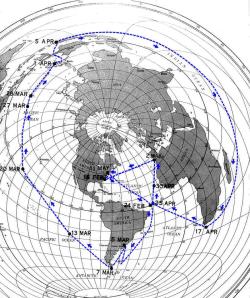
Voyage of USS Triton
A good story for the lockdown.
In February 1960, the USS Triton set out on a most unusual shakedown cruise. The nuclear-powered radar picket submarine sailed from New London, CT, and returned in May, having circumnavigated the world submerged, becoming the first submarine in history to do so.
In an overall voyage of 84 days, the circumnavigation itself, starting at and returning to St. Peter and Paul Rocks, took 60 days and 21 hours, traveling 26,723 nautical miles at an average speed of 18 knots. USS Triton’s course retraced Ferdinand Magellan’s historic first circumnavigation.
The Triton was commanded by Captain Edward Beach, the decorated World War II submarine commander and best selling novelist.
The project was originally dubbed Project Magellan but finally code-named Project Sandblast on the basis that it would “take a lot of sand” on the crew’s part to be successful. “Sand” was also Captain Beach’s code name during the voyage.
On May 13, 1960 the New York Times wrote: The first underwater circumnavigation of the globe is a triumph of human prowess and engineering skill, a feat which the United States Navy can rank as one of its bright victories in man’s ultimate conquest of the seas.
Most of the official celebrations for Triton’s submerged circumnavigation were canceled, however, due to the uproar over the shooting down of a US U-2 spy plane by the Soviets, which sparked a major Soviet-American diplomatic crisis that led to the collapse of the 1960 Paris Summit.
Here is a short documentary from 1961 of the circumnavigation of the USS Triton.
SAGA OF THE TRITON 1961 OPERATION SANDBLAST CIRCUMNAVIGATION OF THE GLOBE UNDERWATER

An extremely unusual submarine in many ways. I went to Wikipedia expecting to find a variation on other boats of the day but instead– a myriad of unique features.
I’ve not found details about air supply for crew members. Did this trip include any snorkeling for fresh air? I seem to remember that US nuclear subs had/have some air regeneration capacity.
I don’t know the answer to the question. I have read that in addition to scrubbers to take out the CO2, subs have either high-pressure O2 bottles or use oxygen generators to make oxygen by electrolysis. What they do with the hydrogen is unclear to me.
I also liked Adm. Rickover’s quick fix for the overheating shaft bearing during trials: “put a hose on it.” 🙂
Nuclear submarines have an oxygen generator that uses electrolysis to separate the hydrogen and oxygen molecules from sea water, The hydrogen is immediately pumped overboard and the oxygen is pumped into oxygen tanks. O2 levels are regulated by bleeding oxygen into the sub as needed. Obviously, bleeding anything into the closed environment of the sub raises the pressure within the ‘people tank’. To lower the pressure in the sub an air compressor (or 2) are started to fill high pressure air banks used for emergency blows and for ship’s service air to operate torpedo tubes and other components. At some point though the air banks are full and the pressure in the boat needs relief. Sticking the snorkel mast up and just opening the head valve (flat plate on top of mast to keep water out) does this without starting the diesel. This is usually done in conjunction with other housekeeping like raising an antenna for radio traffic. If there is time a low pressure blower can be started to circulate fresh air through the boat. In situations where it is not feasible (under ice) or desirable (doing super secret sneaky things) to raise masts, chlorate candles are used to produce oxygen without increasing pressure. Internal pressure is a constant balancing act, so I am sure the Triton stuck up the snorkel mast a time or two.
Fascinating stuff, Tim, thanks!
According to my records: The explosive hydrogen gas, a byproduct of electrolysis produced oxygen, It’s simply vented overboard.
Captain Beach had a spectacular career. Why did he not make admiral?
Tim,
Very informative. Thanks.
Tim, is there a mechanism for handling compensation for loss of nitrogen in venting?
On a semi-related note, it’s interesting how thermonuclear power has consistently been stalled for use in space due to penalties associated with shedding waste heat, while here w/submarines we see what can be done with copious amounts of electricity available (electrolysis!) and some place to dispose of waste heat.
In response to Doug’s question:
Nitrogen is preloaded prior to getting underway into high pressure N2 banks. Both the O2 and N2 banks are located external to the pressure hull in the ballast tanks. Like the oxygen, nitrogen is also bled in as needed. CAMS (Central Air Monitoring System) is monitored constantly and adjustments made accordingly.
Other notes:
There are also carbon monoxide burners onboard that deal with cooking by products (hopefully not truly burnt meals). Cigarette smoke is a thing of the past so the burners don’t work as hard. They do however produce CO2 and water in the process. Air flow is such that the outlet of the burners goes directly to the scrubbers. Water empties into the sanitary system.
Hydrogen is pumped overboard as fast as it is produced. The oxygen generator (aka The Bomb) has an alarm on it that can be heard several 1000s of miles away. It will get your attention.
I suspect Captain Beach did not make admiral because he rubbed too many desk bound members of the selection committee the wrong way.
You’ve answered a lot of questions some of which (nitrogen) for my own part I’ve wondered about for a long time. Thanks so much, Tim.
Great film – in style and in content. Thanks!